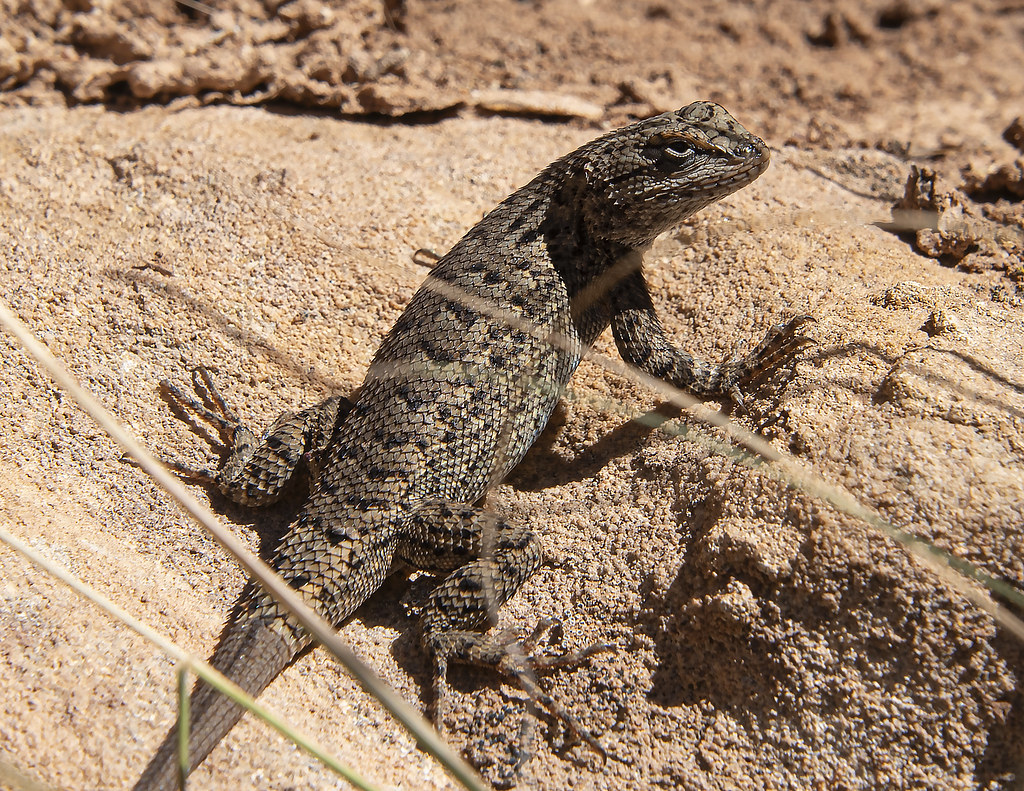#desert spiny lizard
Text
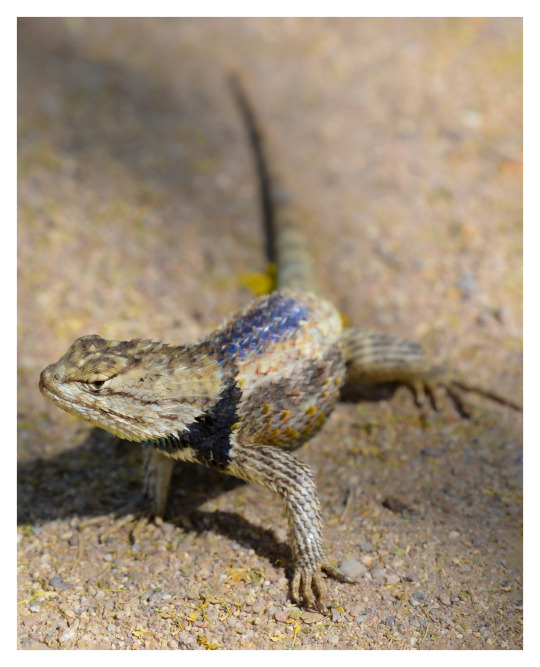
The bodybuilder.
A stout desert spiny lizard (Sceloporus magister) performing his push up territorial display. At Tohono Chul, Tucson, Arizona.
#photographers on tumblr#desert spiny lizard#Sceloporus magister#territorial display#Tohono Chul#Tucson#Arizona
147 notes
·
View notes
Text


#lizard#camouflage#arizona#desert spiny lizard#photographers on tumblr#textless#amadee ricketts#macro#in the yard#leaves#wood#face#eye#texture#hiding in plain sight
45 notes
·
View notes
Text
What's Going On Here?
“What’s Going On Here?” (Two Desert Spiny Lizards) — Image by kenne

View On WordPress
0 notes
Photo

Desert Spiny Lizard - April 2022
This Desert Spiny Lizard was walking along the curbing at the base of the hummingbird bush where I captured the image of the hummingbird. When the hummingbird flew away, I saw movement at the base of the bush and thought it was another hummingbird. Instead it was a lizard, which stayed in place long enough for me to capture several images. As is usually the case with lizards, when I tried to move around in front of it, it skittered off under the bush.
MWM
1 note
·
View note
Text
SandWing tribe sheet!
Here's tribe #2! i find myself liking sandwings more the more i think about them :) they'e definitely one of my less changed tribes, i like joy ang's design for them so i just referenced some desert lizards to give them a little more uniqueness and mostly left it otherwise. hope yall enjoy!

Edit: I ended up changing the blood color a little to be more interesting :)

Physical Appearance + Traits:
-SandWings, in stark contrast to MudWings, are the smallest of Pyrrhian dragons. They are very light, and barely more than half the height of some taller tribes.
-Their appearance is most comparable to other desert reptiles, particularly the horned lizard, with spines, ridges and darker markings across their sides.
-SandWing coloration usually lands on the spectrum between gold and white. Sometimes a more yellowy color might be seen, and rarely, a darker brownish tint. Their colors reflect desert sand, and allow them to bury into it unseen, whether for shelter from enemies or the blazing sun. Despite lighter SandWings performing better under desert conditions, those with darker coloration are often seen as more attractive, and dark tattoo patterns are popular.
-Darker scales near their eyes absorb light, allowing SandWings to see despite the sometimes oppressive glare of the desert sun. They also have an extra eyelid to protect from sand and dust.
-At the end of their tail is a barb that can inject lethal venom at its most potent; SandWings themselves have some level of resistance to the venom.
-They have stiff, upright fans, or ridges, along their backs, which help with temperature regulation; when hot, the veins within fill with the body’s warm blood, and the high surface area allows it to cool off quickly. The same process can also be done with the wing membranes, though a bit less effectively due to the thick scales on the outside of the wing.
-SandWings have thick, dark skin lining their mouths, which protects them both from sun damage and the spikes and thorns often found in desert food (cacti, spiny lizards, etc). They also have a high tolerance to some toxins, and to alcohol resulting from fermenting fruit. (This is true of RainWings as well.)
-They eat little and drink less, like all animals surviving under desert conditions. One good meal a week is all SandWings really need, and usually they get enough water from the food they eat that they don’t need to go in search for more.
-SandWing fire is not as suited for combat as that of other tribes. They can’t produce very much of it at once and it’s more akin to natural fire than typical dragon fire. It certainly can be used to fight, but they prefer to fight with tails and claws; their fire is better used for food and light.
-SandWings are good fliers, and can glide long distances without needing to land and while using minimal energy, but more notably, they’re also the best runners out of any tribe. Their stamina and ability to walk or sprint over vast stretches of desert is unmatched, and some prefer it over flying.
Life Cycle:
-SandWings lay between one and three eggs; usually it’s just one or two, and three is somewhat uncommon. They incubate for a short period of time, usually just three months, and hatch small but able to fend for themselves. SandWing dragonets lack a ridge along their backs, which makes it easier to bury themselves in the sand to stay safe, and their venom, while less outright deadly, acts much faster and usually induces sharp pain, nausea and even minor paralysis. It’s effective at keeping them safe from predators.
-SandWing parents - mothers in particular - are usually present and able to look after dragonets, so these defense mechanisms are only in place as a last resort.
-Dragonets have distinct “young”, “adolescent” and “adult” phases of growth, and usually reach adult size at around seven years. Like all dragons, they do continue to grow, but very minimally in their case.
-SandWings do not generally partner for life, and exclusive monogamous coupling is not the societal expectation. Some do it, but it’s more common to jump between short relationships based largely on physical attraction. Fathers aren’t usually expected to help raise dragonets.
Society and Culture:
-At a time, SandWings were one of the most organized and well-educated tribe, but later they became divided into two very distinct groups: Palace SandWings and Scorpion Den SandWings. These titles aren’t literal; not all “high-class” SandWings live in the palace, and not all street-dwelling SandWings live in the Scorpion Den, but these places are fairly representative of their group. In the palace and nearby areas, SandWings keep up with news and are typically well-trained in combat, in service of the queen. The Scorpion Den, meanwhile, is an infamously criminal town where dragons aim to survive and scrounge for anything they can get. Run largely by assassins and hired theives, this town is to thank for the ‘shifty and untrustworthy’ stereotypes often pointed toward SandWings.
-SandWings in general, in later parts of history, are more focused toward physical training than education, but the Den, as well as other scrappy and chaotic outskirt towns, has changed general perception of them in a somewhat negative light.
-They are known for heavy slang and “colorful” language, including those in the palace, and when paired with regional accents of some of the outskirt towns, some other tribes find SandWings difficult to understand if they speak too quickly.
-SandWings eat rarely, and as a result they sometimes reserve eating for specific occasions. To celebrate, they conduct tribe-wide parades and festivals, and these are often the main time for treats and feasts. At these times, they indulge in (usually roasted) foods - insects, lizards, birds - seasoned with a variety of spices, and elaborate fruit dishes that often include rainforest delicacies brought by RainWings.
-The events inspiring such celebrations usually revolve around celestial movement. Solstices, moon cycles, eclipses, etc. are all celebrated to different degrees. SandWings worship day and night equally, and the sun and moons have equal cultural significance to them. The unity of the two keeping the desert in balance is what they care about.
-SandWings, in fact, are so intrinsically connected to time and movement that this is thought to be the reason behind their musical inclination and sense of rhythm. Music and dance are another major part of these parades, and SandWings have a great love for engaging and complex rhythmic music. Those watching from the sides will often swish sand and rattle their scales in time with performances. (RainWings are commonly invited, to bring their food and dance with the SandWings, as SandWings greatly respect their skill.) SandWings also have a particularly hard time coping if they are removed from the day cycle; it can be extremely disorienting and unpleasant.
-Jewelry, gold especially, is extremely popular and can be worn to excess. It’s also common to tattoo or bejewel scales to the preference of the individual.
Diet: Omnivorous. Will eat almost anything available: insects, reptiles, mammals and birds; cactus fruit, cactus itself, coconut, nuts; and a wide variety of spices, many of which are outright poisonous to other tribes.
70 notes
·
View notes
Text





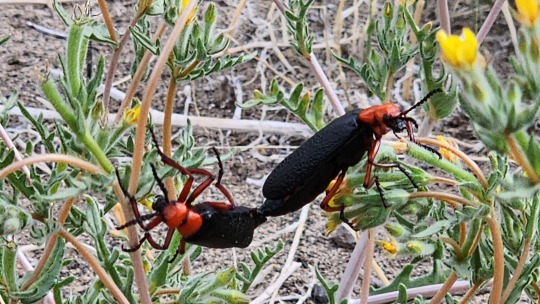







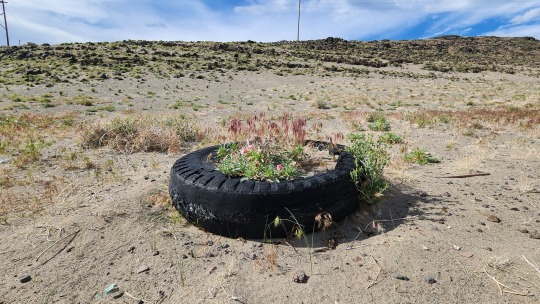




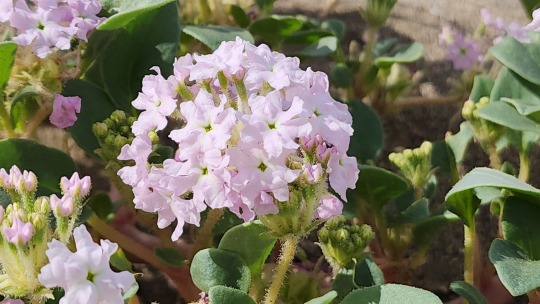

"Home means Nevada,
Home means the hills,
Home means the sage and the pine." (Nevada State song since 1933)
It also means I have to be out in the desert enjoying why I live here.
After the events of 2 days ago I changed the way I was loaded but was not deterred.
The desert was full of life, I followed 4 different snake trails, found no snakes. There were Jack Rabits, Desert Horned Lizards (Horney Toads), Desert Spiny Lizards (Blue Belly's), Western Whiptails, and Zebra-Tailed lizards everywhere. I love seeing the desert come to life in the Spring.
As with all things the desert will take over and take back all the crap that man leaves there. That was evident with the Desert Primrose filling in an abandoned tire. There were a ton of Desert Primrose, Desert Sand-Verbena and bit of Apricot Mallow. There were a few Indian Paint Brushes budding but still not in bloom.
Something new to me after a lifetime here was the massive Master Blister Beetles in the Brittlebush doing Discovery Channel stuff.
I also policed up 9 pounds of spent brass, mostly .45 ACP and 5.56.
To top it all off a nice cooling desert thunderstorm came in and cool everything down.
Not a bad day.
30 notes
·
View notes
Note
Top 5 reptiles!! (Also love your blog and your fics 🩷)
Top five reptiles...
Saltwater Crocodile (for... reasons)
Galapagos Giant Tortoise
Desert Spiny Lizard (very tiny fellows in Arizona)
Western Ribbon Snake (very small garter snek.)
Muttaburrasaurus (Which I think is technically cheating, cause dinosaurs aren't strictly reptiles? Or maybe they are XD )
And thank you =3 I'm glad you like my blog \o/
8 notes
·
View notes
Text
Viva Piñata: Trouble in Paradise


So, two years after the first Viva Piñata, Rare released Viva Piñata: Trouble in Paradise. Trouble in Paradise is more of an expansion pack to the original game than a full-fledged sequel, since most of the gameplay and mechanics remain the same, with the major changes being that a handful of new piñatas, plants, and decorations, as well as two mini-gardens which can attract their own sets of piñatas, the Dessert Desert and the Piñarctic. These gardens are all sandy and snowy respectively - two ground types you can add to your own main garden - but are otherwise completely empty and only serve to be places to set traps to catch exclusive piñatas.
Other small changes include updating or changing certain piñatas resident or romance requirements, and cleaning up the overall presentation quite a bit. Like, the original Viva Piñata just used comic sans font, but Trouble in Paradise has its own unique font. Much less distracting, if you ask me.
While Trouble in Paradise is advertised as having over 100 piñata species, it only adds just under 30 new species, in addition to the previous game’s 60. Maybe they’re counting Sour variants as well, or each individual color that the butterfly piñatas come in. Regardless, it just means that I’ll be covering a smaller selection this time, but that doesn’t mean these new piñatas are any less worthwhile than the ones from the first game. Unfortunately, though, most of the new piñatas don’t have clean renders like the ones from the first game, so you’ll have to be a little patient with what I’ve got.
Sweetle

“Ancient Egyptians worshipped the God Khepri, who was associated with the beetle. On Piñata Island, the Sweetle is just another bug, so don't let it convince you to lend it money. Despite what it says, it does not have worshippers who will pay you back next Thursday.”
The Sweetle is one of the first new piñatas you’ll find in Trouble in Paradise, being the introduction to your escapades in the desert. Sweetles are pretty cute, being squeaky little round lumps meant to resemble beetles. Sweetles don’t resemble any particular kind, but with their flat ‘nose’ resemble hercules beetles, kind of. One of the wild card variants comes with a pincer-like horn, though, instead resembling a stag beetle.
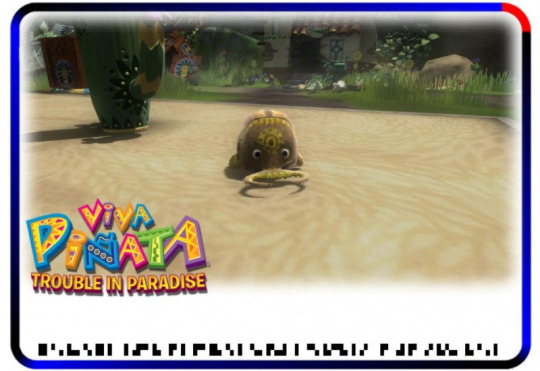
That’s a great description too. I’d like to imagine most Sweetles are little con artists to try to swindle you out of money if they get the chance. That’d be an amusing characterization for a little beetle critter.
Geckie
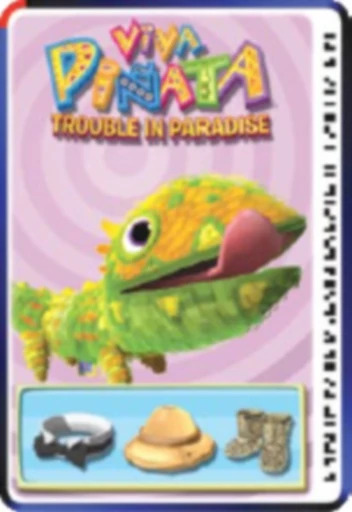
“This little lizard piñata enjoys the bright sunshine and sand between its toes. Of course no-one would find living in a desert much fun unless they had already caught a bit too much sun... and accidentally roasted their brain. I'm sorry, did I say that out loud?“
Geckies are another new addition found in the desert, which resemble bearded dragons more than they do geckos, thanks to their more arid habitat and spiny backside. A little lizard was sorely mistaken among the first game’s roster, so I am happy to see one included in the sequel. They even lick their eyes in some of their idle animations, which is a great little touch.
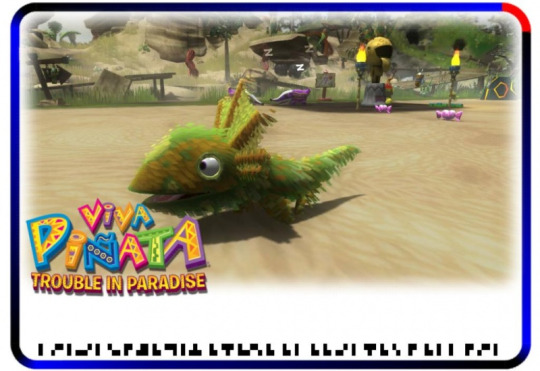
One of the Geckie’s wild cards actually gives it a large crest around the back of its head, now making it resemble a frilled lizard, which is quite cool as well! Combining two lizards into one is quite efficient if you ask me.
Custacean

“Where you find a beach, you'll find these little Piñatas. They tend to be a bit grumpy, because those claws are not ideal for evenly spreading sun lotion, and they almost always get sunburned.”
I am also very glad to see a crab added to the piñata encyclopedia as well! Look at it, it’s such a cutie. I really like all the patterns on its body, which works pretty well even with how small the crab is in-game. It even walks sideways, as all crabs should. Hilariously, Custaceans require a surfboard to be in the garden in order to become residents. It’s not like they’ll be using it for anything, but anything that reminds them of their home is sure to be a welcome addition.
Cherrapin

“This Piñata is perfectly adapted to its life. It has strong flippers to pull over land and through the water. It has strong jaws for feeding and it has a tough shell for... er. Well, obviously to protect it from... er birds. Yes birds flying overhead, carrying... anvils, and er... pianos.”
Trouble in Paradise seems to have a pension for adding more aquatic piñatas, with the Cherrapin also joining the encyclopedia. Cherrapin is distinctly a sea turtle, as it can only drag itself around with its flippers rather than walking anywhere. It’s definitely more at home in the water, so make sure to have a pond in your garden if you ever plan on keeping one around. Otherwise, not much to comment on, but another cute critter for the collection.
Pengum

“Pengums left the jungles of Piñata Island to avoid a lifetime of servitude. The bigger, meaner Piñatas forced them to work as waiters. When they found the Piñata Island ice fields, they thought they'd found a safe new home. Unfortunately, they were penniless, so they set up a cafe where they could... er, serve the other Piñatas.”
I really don’t know what some of these encyclopedia quotes are supposed to mean. What are you talking about, dude.
Penguins were also added in order to populate the Piñarctic, and are also a welcome addition. They seem to be based more on the rockhopper family of penguins, given the yellow feather patches on the back of their heads. The elongated beaks are a nice touch too. For whatever reason, though, Pengums have an appetite for Newtgats, and will only live in your garden once they’ve eaten one. It’s really best not to get too attached to a lot of the piñatas in these games, they’ll either become prey for bigger piñatas or get smashed by the unexpected Professor Pester visit. I mean, you are raising them to get sent to parties, after all.

Regardless, if you breed Pengums enough and end up getting a wild card, you might get one of these types with a rocking mohawk! All that excessive reproduction is kind of worth it for these more wacky stylings.
S’morepion
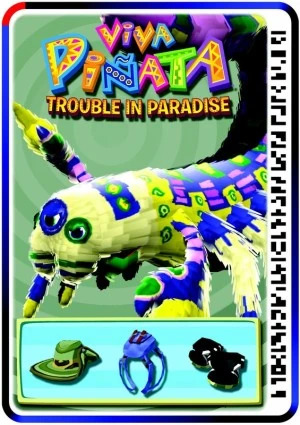
“If you have these Piñatas in your garden, make sure you check your boots before starting work. S'morepions love the cozy confines of footwear to nap in, and they will sting you if you threaten to crush them with your feet.”
Adding another arachnid besides the Arocknid, the S’morepions are also residents of the desert which can be caught and brought to your garden. It seems a bit softened up in comparison to the Arocknid, given the more rounded-out pincers and stinger it has, though. The three eyes are kind of cool, though. S’morepions are also finally another piñata with a utility usage, being able to use its sting to stun and ward off any troublemaking Ruffians who wander into your garden. Amusingly, Arocknids and S’morepions also will not get along, and will start fights with each other if inhabiting the same garden.
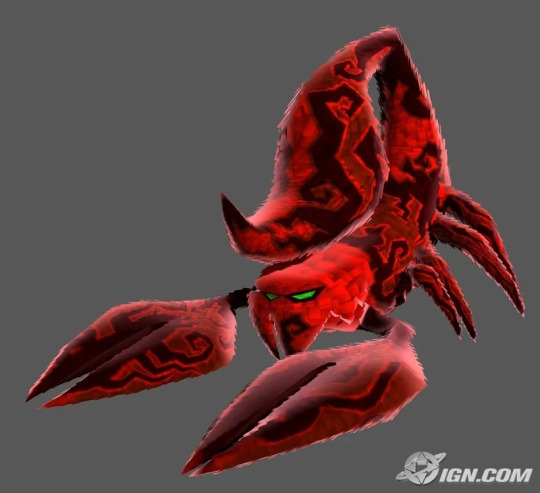
S’morepions also initially come in Sour Variants, once again sporting a rad red and black color scheme with jagged patterns and curls. The stinger being so oversized and hanging down like a bulbous fruit is a cool visual too, sort of emphasizing how dangerous it is. The three thin green eyes and sharper pincers and stinger look even better on this version. The Sour S’morepion is wicked enough to use its stunning sting on your own piñatas, so you’d better watch out for that.
Limeoceros

“When Piñata Central was built, they needed a way to transport Piñata around the island. Limeoceri love to dance an Irish Jig, so they brought in off-road trucks, equipped with Irish folk music and loudspeakers. As the Limeoceri followed the music, they hammered new roads over Piñata Island.”
The Limeoceros joins the other big, dopey mammals of the African grasslands like the Elephanilla and Chippopotamus (which I admittedly neglected to cover earlier) come Trouble in Paradise, and has a nice, charming design to go with it. Something about the mostly purple and magenta palette with green lines is quite pleasing to the eye, even if it’s far from whatever I would expect a rhinoceros to wear.
The Limeoceros is also maybe the most helpful piñata you can own, since as long as it’s in your garden you can use it against Professor Pester whenever he enters you garden. Normally, if Professor Pester wanders in, he’ll smash your most valuable piñata unless he’s bribed with a hefty sum of cash. Having a Limeoceros around though will cause it to charge into him and send him flying into the horizon like Team Rocket.
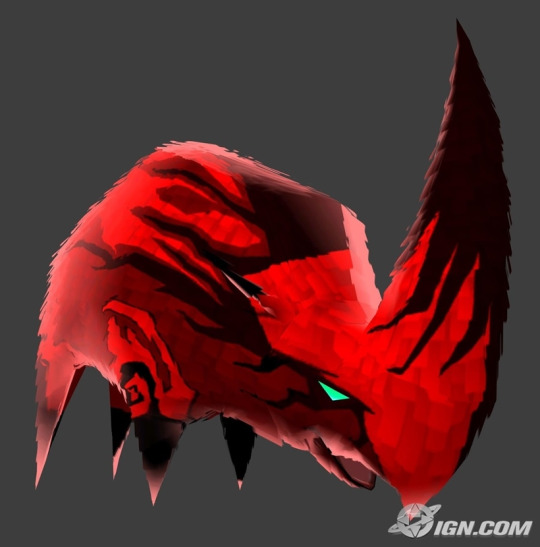
Limeoceri first must be cured of their Sour status before protecting your garden, though. Like the other Sours, I dig this thing’s palette quite a bit, as well as how exaggerated and angular it is. Every extension on the Sour Limeoveros’s body ends in a sharp point, which is both funny with its legs and cool with its horn. What isn’t cool is that the Sour Limeoceros will smash buildings in your garden whenever it’s around, but that’s life I guess.
Sarsgorilla

“Here we go again, another video game with a big ape in it. Can someone explain to me why the guys who write games are so fascinated with really big apes?”
Incredible description aside, while the first game has its fair share of Cinnamonkeys and Bonboons, it was lacking in big, great apes, which is where the Sarsgorilla comes in. This hefty piñata is a great combination of bright greens and deep blues, again, not what I would expect of a gorilla but makes for a swell combination.
They really don’t stop when it comes to Donkey Kong references with the Sarsgorilla, either. Not only is its projectile weapon of choice barrels, but it also refuses to breed unless it’s wearing a funky necktie too. That paired with the description makes me concerned if Rare were really missing working with DK while they were under Microsoft’s tenure.
The Sarsgorilla is also infamous for being stupidly difficult to attract and tame, even in comparison to other difficult piñatas. To even enter your garden it requires a baby Bonboon resident to be present. The problem is that baby piñatas obviously won’t stay babies forever, and that it’s impossible to tell if a Sarsgorilla is anywhere close to spawning outside your garden at any given moment. You might have a baby Bonboon wandering around your garden, and no Sarsgorilla in sight. Or, you may have one with a Sarsgorilla nearby, only for the baby Bonboon to grow up before it can enter, causing it to lose its requirements and wander away. Once the Sarsgorilla does manage to enter your garden, it’ll then need to eat an excessive amount of food, including 4 coconut macaroons, 4 jars of peanut butter (both of which need to be transformed from regular plant-based items) and 6 bananas. Food in Viva Piñata can expire and go rotten if left out too long, by the way, so you better be ready when a Sarsgorilla randomly shows up, lest you be missing one ingredient and ruin the whole encounter.
Really this kind of stuff isn’t too out of the ordinary for some of the other late-game piñatas, I just haven’t mentioned most of them since I didn’t find their designs too interesting to comment on. That hippo piñata I mentioned earlier needs half of your garden to be made of water, and three different plants to be growing in the garden as well, each currently having 10 living instances. You just kind of get used to these insane requirements the longer you play.
Jeli
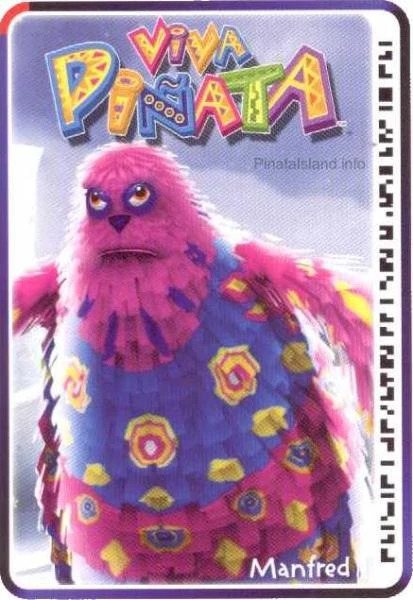
“At the frozen top of Piñata Island, where icy winds scour the snow, lives the elusive Jeli. It's not the location I'd choose to live in. Still, you never get stuck buying presents - woolly hat, scarf, mittens even... “
Not to be one-upped is the ever-elusive Jeli, an incredibly rare piñata (rather vaguely) based on the yeti. It very rarely shows up in the Piñarctic, where it first must be caught in a trap (which has the chance of failing and scaring off the Jeli, by the way) before it can be put in your garden and tamed proper. Once there, it only needs a few berries and banana splits to become a resident, but good luck finding one in the first place. Like most other piñatas, there’s no guarantee of it showing up at any given moment, so you just have to keep checking in hopes of it appearing. In terms of design, it looks alright, but I don’t know if I’d really call it a yeti. More of some off-the-wall Dr. Seuss character, really. No offense, though. It matches the rest of the game’s wackier offerings.
Jelis are even more enigmatic in the DS version of Viva Piñata, Pocket Paradise. There, the Jeli can randomly spawn like every other piñata, but the specific conditions of it doing so are a total mystery. For years, players wondered how exactly they could get a Jeli to consistently appear... only for one of the original developers to come on Twitter and reveal that Jelis only have a 1/3 to 1/6 chance of spawning per save file. It’s entirely possible to roll the wrong dice and have Jelis be twice as rare in your game as they are in someone else’s - not that a 33% is the best odds anyways.
Choclodocus

“Were there prehistoric Pinatas? I thought Pinatas were discovered in China by Marco Polo who then brought them to Europe. The tradition then transferred to South America by Spanish explorers. All this was a long time after dinosaurs. It's as if someone wanted be cool without thinking it through properly. “
Trouble in Paradise also comes with its own ‘ultimate piñata’ like the first game’s Dragonache, only this time being the dinosaur-themed Choclodocus. Like the Dragonache, the method of finding and making one your resident is rather complex, only this time it comes with a plethora of customizable options. First, you’ll have to obtain an Amber Gem item from donating 9999 coins to a wishing well you can build in your garden after reaching the end credits. Then, you’ll have to buy a Red Bone from the decoration shop, and then hope to find Blue and Green Bones from random Mine usage. After collecting all three bones, you’ll have to get them transformed into skeleton parts, though the order in which you do it has an effect on how the Choclodocus will be built. This chart displays each part.

Once all four items are obtained, they must be put into a storage unit, and then an egg will pop out, which a Cluckles will have to hatch like the Dragonache. However, the Cluckles must be wearing a wig hat that has a bone through it, its prehistoric style being your only clue as to the fact that it might be necessary. Even after hatching the puzzle won’t be over, since the Choclodocus also needs its own set of five items and piñatas to eat in order to mature into adulthood too.
I did praise the Dragonache for having a complex method in order to unlock one, but the Choclodocus might be a bit too complex. Absolutely none of this is explained or clued in to you, especially stuff like what the Choclodocus needs to eat, what the Cluckles needs to be wearing in order to hatch it, or even that all of its pieces need to be put into storage to make an egg. If it was hinted at in some capacity then I’d warm up to it more, but sadly most players will likely feel forced into following a guide rather than figuring it out for themselves. Luckily none of the items needed to make the egg can be sold or destroyed, so you’ll never be softlocked out of it, but still.
REGARDLESS, though, I think the Choclodocus is a nice design for a piñata and does a good job being another final reward like the Dragonache. The customizablility is the real strong suit here, even if the options aren’t exactly all equal in their quality. I would assume most people would feel compelled to give it the Triceratops head, since the other two hardly resemble dinosaurs specficially, and the fan-shaped tail made by the Green Bone doesn’t have as much flair as either of the spike-tipped ones. Still, the Choclodocus is neat for giving you a big dinosaur to care for alongside the more regular animals of your garden, and looks charmingly dopey like a lot of the other paper-mâché fauna. Also, while the Dragonache can scare any Ruffians and Sour Piñatas out of your garden, the Choclodocus can raise any piñata’s happiness to its maximum value, allowing them to sent off to parties much easier. It’s definitely worthwhile to have around even if you aren’t charmed by it yourself.
HONORABLE MENTION: The Platypus

Concept art is included in Trouble in Paradise, and when browsing it you can find this mockup for a platypus piñata that never was. It seems like it would’ve been a hidden piñata produced through crossbreeding two different species, like the Pigxie before it. The platypus, though, is much more lucky in that it ends up as a more natural animal rather than a deformed mutant. Given the Choclodocus’s parallel to the Dragonache, I’m surprised they didn’t include this parallel too, but maybe the developers didn’t think it was worthwhile to include yet another hidden piñata in the game that players had a chance of never finding. Plus, the Pigxie requires a special house to be built for its parents to Romance in, titled the Mystery House. Maybe they had trouble trying to figure out how to include two different Mystery Houses, I dunno.
HONORABLE MENTION: The Shark
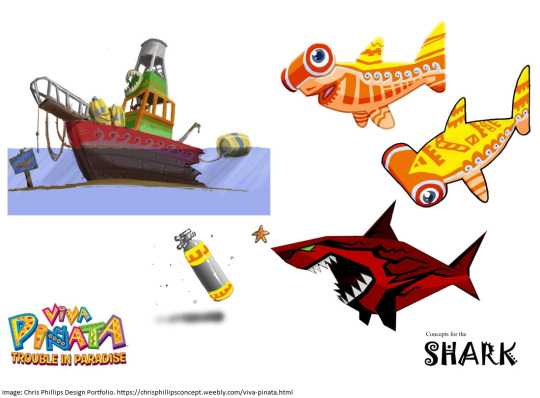
Awwww, this one really stinks. You’re telling me there could’ve been a cool, menacing Sour Shark, and a dopey and cute hammerhead shark in these games too?? I love how the normal version of the shark has little rolling waves as the pattern lining its body, that’s great and gives it a wonderful little aquatic theme. And look at that wrecked boat that would’ve been their house, that thing’s great! I would love to have that in my garden, even just as decoration! What gives??
Apparently, the word is that the developers couldn’t find a way to make fully-aquatic piñatas work well within the game, since ponds in gardens are only a foot deep and players can easily cover them up with dirt at any time. They’d get forced out of the water and have nowhere to go, which created a problem. As such, only amphibious piñatas were kept in the game. Sadly the concept was dropped and without a third entry to the series the idea was never explored again. Apparently a goldfish piñata was also planned at some point, since there’s a shopkeeper who has one in a fishbowl, but you can never get it yourself.

Well, that’ll do it for covering Viva Piñata on my blog! I realized a little late into writing there was more I could’ve talked about from the first game, since it is amusing trying to explain how needy some of these piñatas are when it comes to getting them to live in or even visit your garden, but the point of these reviews is moreso supposed to be on how they look and hold up as designs. Though, for how much i like some of them, there’s only so many ways I can say they look cute and have nice colors.
Nevertheless, I find most of the piñatas of these games to be quite charming, and am very impressed by all the work Rare put into making them. I hope I’ve introduced some people to the games’ charm, or reminded old fans of what they’ve been missing. I really hope there could be some new attention given to this series, hell I’d take even a PC Port of Trouble in Paradise over a fully new third game, but given how most of the classic Rare staff don’t work at the comapny anymore, and it’s been several years since the release of Rare Replay, I won’t hold my breath. Still, no harm in talking about the content that is here. Maybe we will see more piñatas some day, who’s to say.
18 notes
·
View notes
Note
let's see here....more headcannons? I HAVE THEM ALL!!
you might not be interested but I'll drop my headcannons for their zodiac signs!
Hanako and Tsukasa are canonly Sagittarius but shushsyhsgsys Hanako is my eyes screams such Leo I can't, and Tsukasa says Gemini, I know this hc is impossible but....🥹
I have a hard time deciding but Aoi is either pisces or Taurus, she could also be a Scorpio for.....self indulgent reasons....
ah yes, Akane is 100% our Taurus, loved the idea of the the Aoi's being tauruses but Aoi is hard to decide
Teru ah Teru... he is our Capricorn
Kou is like an Aries ykkk
I know it's funny but Nene is a Sagittarius to me always, the funny part is Nene and the Yugi brothers share a birthday month(sorta)
hear me out, Fake Mitsuba is Scorpio and real Mitsuba is Cancer
Natsuhiko you sly Virgo
I DONT MAKE THE RULES SAKURA IS A SCORPIO
okay okay I'm done I shall commence, MORE HEADCANNONS!!
fuckkk I can't remember if I've mentioned this hc but ykw it's very precious to me so I will put it here in case
AKANE OWNS A DESERT SPINY LIZARD!!! he loves his lizard and takes good care of him, his name is Aoi, after his lovely Ao chan, who is in fact scared of the lizard
Natsuhiko brings soup and snacks ect to have with Mitsuba and Tsukasa (sometimes Sakura) and they just watch television together (yes there is a tv in kamome idk why but it's canon)
Natsuhiko is fearless, except when it comes to mice! he can't stand them!! so scary
Teru used to be left handed but was taught to use his right because it was traditionally still seen as devilish by the priests, so now he uses his right and can't use his left for shit, he also has the worst most ugly and uncomfortable looking hand posture when holding a pencil but he somehow knows how to force better beautiful hand posture in front of people. it's terrifies Akane every time
Teru bites his nails....sad truth, he gets very self conscious of them in public
Kou accidentally adorned Teru's biting nail habit, he tries his best not to though...
Kou is dislexic okay?!??!? it's so true.... @teruwasright was the one who brought it up awhile ago can't stop thinking of it
in early mornings Tiara likes to sit at the corner to the kitchen and listen to Kou talk to himself, it's one of the only ways she's able to know how her brother feels.
Tiara steals and plays on Kou's switch (it's fine because Kou isn't much of a gamer) and loves to run around and catch Pokemon so her brothers got her let's go!Eevee (they had to fight over which one she would like Kou said Pikachu and Teru said Eevee) and she can't stop playing with them! she nearly cries everytime a Pokemon faints so Teru battles for her (and secretly plays some for her character to go farther also he's a game addict) her favorite type is Fairy!
Sakura barely gives a shit whether her skirts flair up in the wind but she does make sure they don't just to be modest, also it comes naturally for nature to never ruin her hair or clothes idk...
Amane used to feed a stray cat and thought of the cat as his only other company, the cat went missing though
okay I'm done for today
WAHHHH THESE ARE LOVELY i love the broadcasting club one i feel like someone would bring in a gaming console or something too and theyd watch tv and play video games together
AND the one where kou talks to himself and tiara listens i love that so much it works so well
i love all of these so much theyre very canon
#ask#tbhk#sorry it took so long to respond!!! i have been Busy#i love these#you have all the best ideas#literally every idea
13 notes
·
View notes
Note
Please and thank you: tell me something about the desert, I’ve never met one, but would like to. Something big or small, just something lovely?
in the sonoran desert, when it rains during the monsoon, the desert petrichor mingles with the exudates of the creosote/chaparral and makes the most incredible scent. i smelled in when i visited in 2021 and it made me cry instantly
in phoenix, the introduced mediterranean gecko (Hemidactylus turcicus) has become incredibly common, and most of my childhood lizard memories are either of encounters with them, or with the tree lizard (Urosaurus ornatus). the geckos are really hidey and stay in the shadows and come out at night (you'll see them a lot around lamps eating the attracted insects), but the tree lizards are showy, and they love to dash around on cinderblock walls and soak up the sun, and do pushups at other tree lizards (males have a bright blue patch on their throat). until recently tree lizards were classified as part of a larger Iguanidae family, but were recently re-classified into the Phrynosomatidae family, which also includes the horned lizards* and spiny lizards, and you can see the relation between them in the shape of the top of their skull around the parietal eye. also i just found out that the oldest known member of this family, excavated in Mongolia, has been named Desertiguana, not to be confused with the desert iguana (Dipsosaurus dorsalis) which is found in the sonoran desert (& bordering deserts)
another incredible thing about the desert are tadpole shrimp (Triops) and spadefoot toads (genus Spea and Scaphiopus). during the monsoon these'll pop out of the dust and spend the next week or so fucking in the very temporary pools, and lay their eggs. the shrimp eggs will not hatch (and iirc need to be dried out before they will hatch) and will settle into swiftly drying mud. the spadefeet eggs will hatch and then mature incredibly swiftly, and the little toads will dig into the drying dirt and cover themselves with a membrane that will keep them moist until the next rains come.
also the sonoran desert at sunrise is just incredible, visually, and also aurally. all of the many many species of bird found in the desert sending out their symphonic cacophany into the morning. warbling cactus wren, whistling thrasher's and creaking grackles and the little cheep of the verdin (a little green-grey bird with a bright yellow head that's often found on the palo verde, which has green bark and bright yellow flowers). in some areas you might see gila woodpeckers nesting in holes in saguaros, and in the phoenix area a population of introduced peach-faced lovebirds has become established, and occupy seemingly a niche that nothing else was in, and sometimes you might see them amongst the cactopodes also.
*these fuckers eat ants and are so specialized in eating ants that they have a compound in their blood to neutralize formic acid and if they don't eat enough ants that need neutralized the compound builds up and poisons them. also some species can shoot blood out of their eyes. please don't make them do this
8 notes
·
View notes
Text

Ancardia's Unusual Animals--The Great Sandworm
Classification: Beast (mollusc)
Habitat: Under the dunes and desert soils of the Hazarit region.
The Great Sandworm is the single largest animal on all of Ancardia—and also among the most docile. This does not mean the worm is not a dangerous creature; its sheer sizes reached bring with it the risk of being run over, and the evidence of its travels can become terrible environmental hazards to the unwary traveler.
Limited to the deep sandy soils of the Hazarit, the great sandworm lives its entire life burrowing under the surface between 2 meter depths and bedrock. Living an average of 150 years in the wild, the great sandworm grows to an average of 60 meters in overall length, and about 5 meters in diameter. It has a relatively tiny mouth, but a broad, spiny area around the head which assists in burrowing; it is primarily a detrivore, feeding on long-buried dead material such as plant roots, deceased animals from sandstorms and droughts, and other bits and pieces. It has an extremely slow metabolism, often taking long dormant periods where it barely eats or moves for months at a time. It always becomes active in the brief rainy season in the Hazarit, when it burrows closer to the surface and excavates a hollow to collect rainwater and to lay its egg mass. The eggs, if they are lucky to not dry out, hatch into half-meter larvae which disperse into the neighboring regions, and take nearly 30 years to approach even a fraction of the gargantuan sizes of the adults. Newly-hatched larva are sometimes prey to burrowing animals of the desert, such as golden moles, jackals, and monitor lizards.
Great sandworms create an extensive, crisscrossing network of tunnels, all of which have a number of openings to the surface which the worm will keep its “snorkels”, breathing structures at the end of its tail, protruding slightly from for ventilation. Currently unoccupied breathing pits of these worms end up being dangerous pitfalls to some, and difficult ones to climb back out of in a hurry. Some mortality has been reported from these pits, mostly from injuries, lost fallen folk wandering the worm tunnels and becoming lost before dying of dehydration, and in a few cases of being plowed over and crushed by the return of the sandworm.
#ancardia#ancardian homebrew#bestiary#mixed media#creatures#animals#Ancient Domains of Mystery#ADOM#Dnd-like#giant worm#great sandworm#sandworm
8 notes
·
View notes
Photo

Desert spiny lizard (Sceloporus magister) at the Arizona-Sonora Desert Museum, Tucson, Arizona.
#photographers on tumblr#desert spiny lizard#Sceloporus magister#Arizona-Sonora Desert Museum#Tucson#Arizona
86 notes
·
View notes
Photo



#lizard#desert spiny lizard#concrete#wall#photographers on tumblr#textless#amadee ricketts#arizona#in the yard#fall#autumn#september#macro#camouflage#texture
89 notes
·
View notes
Text
Desert Spiny Lizard
Desert Spiny (Sceloporus magister) Lizard — Image by kenne
These are medium to large lizards with snout-vent lengths ranging from 2¼ to 5¼ inches (63 to 138 mm). These robust lizards have keeled, pointed scales. Background color is usually subdued gray, tan, or blue with a striking wide, purple stripe down the back and single yellow scales scattered on the sides (S. magister), or scattered…
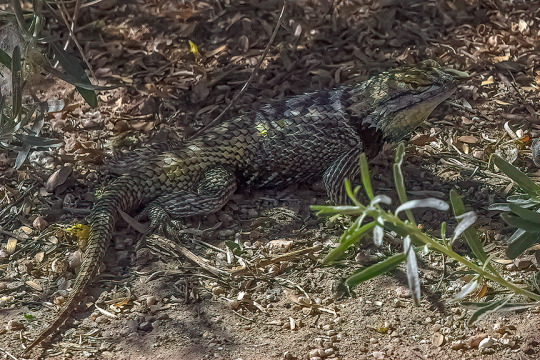
View On WordPress
0 notes
Video
Lizard by Richard Ellis
Via Flickr:
Lizard seen in the Canyon of the Ancients near Cortez Colorado. My best guess is that it is either a Desert Spiny Lizard (Sceloporus magister) or possibly a Prairie and Plateau Lizard (Sceloporus undulatus). Let me know if you have an opinion. #lizard #CanyonOfTheAncients #Cortez
2 notes
·
View notes
Text
Akane Aoi head cannons !!
my Akane brain rot says you get head cannons
he likes to wear oversized crop tops but is too embarrassed to wear out in public.
horror movies scare him easily and he always jumps no matter how much he tries not too. even when he tries to impress Aoi..
he likes reptiles/Lizards and Elephants...
he owns a Desert spiny Lizard, and named it 'Aoi' after his childhood friend.
he HATES when people use the wrong Grammer or refuse to take care of themselves properly. it really gets on his nerves
he has a slight unaware crush on Yamabuki and will never find out that he does. bc I mean, everyone wonders what it's like to kiss your friend..
he's ambidextrous! but uses his right hand most of the time by default bc Aoi does.
he has Internalized homophobia and can't accept that he likes guys.
Akane knows and loves Folklore dancing ! he actually takes classes three times a month :)
his favorite thing about Aoi he refused to say was when she cries. he just finds it unbearable cute when people cry, especially the people he cares about.
he legit got a potted plant to put in the student council room and named it 'president' to confuse Teru when he speaks to the plant bc he's an asshole.
he has Sanpaku eyes but tries to keep them as normal as possible around Aoi bc she mentioned how pretty and wide Nene's eyes are.
he's a Taurus !
he wears his glasses on his head a lot when he doesn't feel like dealing with the glasses in the way of his vision
he not only loves Raspberry treats or anything raspberry, he also loves everything blueberry ! especially blueberry pastries.
he has two Dad's I'm sorry but it's facts to me (but Akane being raised by two powerful mom's sticks with me-)
he's crazy good at volleyball and Tennis and no one has ever beaten him (except Aoi in Tennis once)
he hates artificial tastes ! they make him sick and honestly piss him off.
that's all for now, just a short simple head cannons list !
#Akane Aoi#Akane head cannons#tbhk Akane#tbhk#jshk#toilet bound hanako kun#jibaku shonen hanako kun#akane aoi#jshk manga#manga#aoi akane#tbhk akane aoi#tbhk headcanons
23 notes
·
View notes
